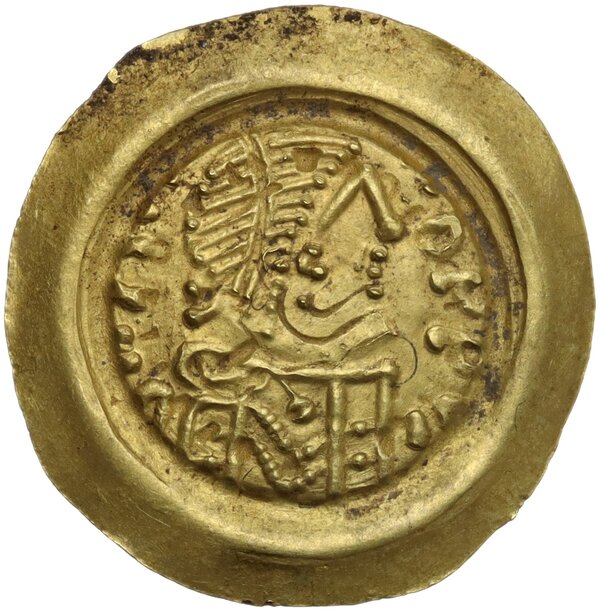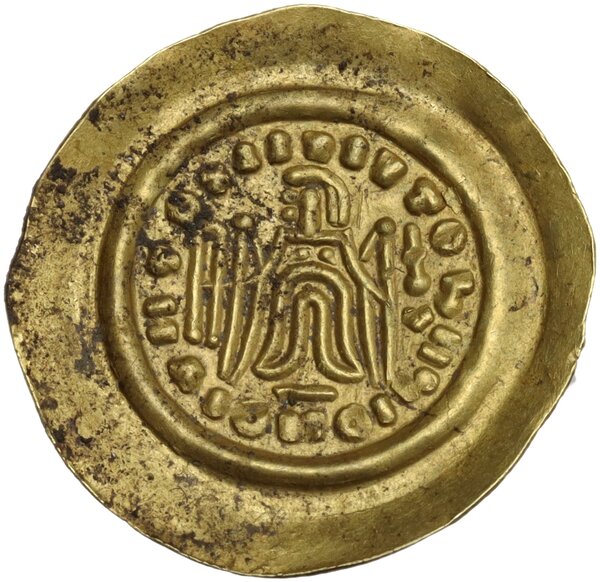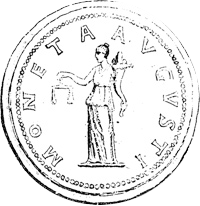Amazing Lombardic Tremissis


The Lombards, Lombardy. Time of Authari-Agilulf (c. 568-690 AD). AV Tremissis. Pseudo-Imperial Coinage. In the name of Maurice Tiberius (582-602), c. 582-690 AD. Obv. Blundered legend. Pearl-diademed, draped and cuirassed bust right. Annular border in high relief. Rev. Blundered legend. Victory standing facing, holding globus cruciger in left hand and wreath in right; COIIOI in exergue. Annular border in high relief. MEC 1, 305-6; BMC Vandals 23 (Agilulf). 1.31 g. 22.50 mm. RR. The letters of the legends validate that this coin is an imitation of Maurice Tiberius' tremissis struck at the Ravenna mint. This type, with its larger flan, was resumed after the period of Cunipert .
Very rare, sharply struck and superb. Broad unclipped flan. EF. The Lombards were a Germanic people who were known since the time of Tacitus. By the early sixth century the Lombards had settled in Pannonia, and adopted the Arian religion. In AD 568/9, the Lombards began to invade Italy and quickly took control of the region from the Alps to the Po valley (later known as Lombardy), and established their capital at Pavia in AD 571 under their king, Alboin. Following the death of his successor in AD 574, the dukes could not agree on a new king, resulting in an interregnum of ten years. During this interval, two other independent Lombard duchies were founded in Spoleto and Benevento. With the exception of Liutprand (AD 712-744), the kings of Lombardy were weak and ineffectual, and the kingdom was finally crushed by Charlemagne in AD 774. The Lombards of Benevento thrived under its first dukes, Zotto and Arichis (AD 571-641), and its control expanded to the whole of southern Italy except Apulia and Calabria. Afterward, attacks from Lombardy, followed by the Carolingians, Byzantines, Papal States, and finally the Arab invaders, kept Benevento on the defensive, and its power waned. A civil war following the murder of Sicard in AD 839 resulted in the breakup of the greater duchy, and a number of insignificant Lombard dukes intermittently ruled over a greatly reduced Benevento until the mid-eleventh century. Like Benevento, the Lombard duchy of Spoleto was constantly assailed from all sides, and lost its independence after falling to Charlemagne in AD 776. Unlike Lombardy and Benevento, Spoleto has no known coinage. (Triton XI, 2006, 1074 note).
Very rare, sharply struck and superb. Broad unclipped flan. EF. The Lombards were a Germanic people who were known since the time of Tacitus. By the early sixth century the Lombards had settled in Pannonia, and adopted the Arian religion. In AD 568/9, the Lombards began to invade Italy and quickly took control of the region from the Alps to the Po valley (later known as Lombardy), and established their capital at Pavia in AD 571 under their king, Alboin. Following the death of his successor in AD 574, the dukes could not agree on a new king, resulting in an interregnum of ten years. During this interval, two other independent Lombard duchies were founded in Spoleto and Benevento. With the exception of Liutprand (AD 712-744), the kings of Lombardy were weak and ineffectual, and the kingdom was finally crushed by Charlemagne in AD 774. The Lombards of Benevento thrived under its first dukes, Zotto and Arichis (AD 571-641), and its control expanded to the whole of southern Italy except Apulia and Calabria. Afterward, attacks from Lombardy, followed by the Carolingians, Byzantines, Papal States, and finally the Arab invaders, kept Benevento on the defensive, and its power waned. A civil war following the murder of Sicard in AD 839 resulted in the breakup of the greater duchy, and a number of insignificant Lombard dukes intermittently ruled over a greatly reduced Benevento until the mid-eleventh century. Like Benevento, the Lombard duchy of Spoleto was constantly assailed from all sides, and lost its independence after falling to Charlemagne in AD 776. Unlike Lombardy and Benevento, Spoleto has no known coinage. (Triton XI, 2006, 1074 note).


